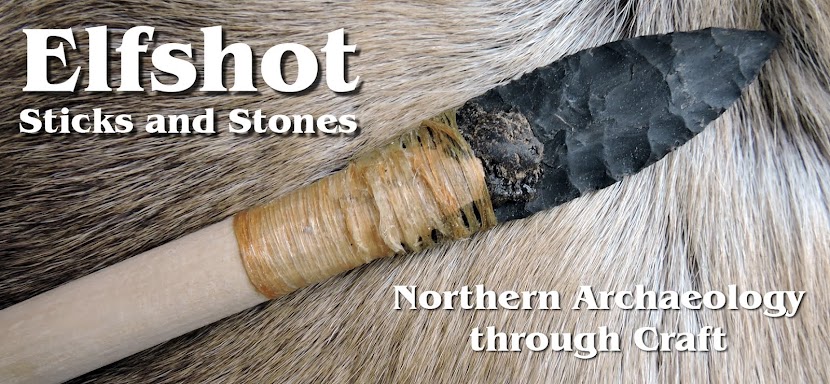 |
| Will it fit? |
I got as far as fitting the Beothuk harpoon head onto the wood mainshaft this weekend. If you recall, the
Beothuk harpoon heads have a very thin slit at the base to fit onto the harpoon shaft. Also, according to Shawnadithit's drawing, Beothuk harpoons lacked the foreshaft seen in many other cultures in the Province, including the Maritime Archaic, Palaeoeskimo, and Inuit. Before making the reproduction, I had a difficult time reconciling this extremely narrow socket with an all wood harpoon shaft. It seemed like the harpoon shaft would have to be carved to the thickness of a credit card in order to fit into the thin slot. I couldn't imagine wood being strong enough to fit such a narrow slot without breaking. I thought perhaps the Beothuk fit the harpoon heads onto the ends of metal lances, although this is contrary to Shawnadithit's drawing. After this weekend, I don't believe that anymore, and I think Shawnadithit's drawing of a foreshaft free harpoon could be accurate.
 |
| It does! |
The main thing that became obvious from making the reproduction was that the thin slot on the Beothuk harpoon is also quite wide. Near the end of the spurs, it may only be a millimetre or two thick, but it stretches nearly an inch from side-to-side. I think the trick to fitting the harpoon head onto a wood shaft is to mimic the diamond cross-section of the harpoon head in the wood shaft. It only has to be thin where it makes contact with the harpoon head socket. If the shaft is left thick in the middle but tapers towards the edge, then it seems to solve both problems; it fits into the very thin socket, but maintains some strength.
 |
The edge can be slightly charred in a
flame and the charred edge ground
away to create a strong, smooth
edge. |
A lozenge shaped or diamond shaped cross-section at the end of the long wood main shaft would work and is relatively easy to make. Its a form that is easy to make by scorching the wood with fire and abrading the edges against a stone. We know the Beothuk used fire to both shape wood and season it, so this would fit within their technological approach to woodworking, as well. For example, a
birch bowl was found at the capture of Mary March that was in the process of being hollowed out with fire and there is an historic account of the Beothuk
seasoning their bows over fire to dry and strengthen them. Using fire to shape the shaft would have the added advantage of further hardening the wood.
 |
It only has to be thin around the edge. The middle can be
left thick, mimicking the diamond cross-section of the
harpoon head. |
I probably had enough information to figure this out logically, but, as is often the case, figuring it out in the workshop was a lot easier. Dorset Palaeoeskimo harpoon heads in this province have a tendency towards being rectangular in cross-section and fit on a rectangular foreshaft. Likewise, Inuit harpoon heads tend to have a round or oval cross-section and fit onto a round or oval foreshaft. The Beothuk harpoon heads have a diamond cross-section, so why shouldn't we suppose that they would fit onto a shaft that also has a diamond cross-section? Its a pattern that I hadn't really noticed before, or explained away as being related to gouged versus drilled holes, but perhaps there is a pattern across many cultures in the northeast that sees foreshaft cross-section mirror the harpoon head cross-section. If I would have noticed that pattern earlier, it might have made understanding Beothuk harpoon heads less perplexing.
Photo Credits: Tim Rast





Brilliant work; there's something intrinsically beautiful about the synchronicity of the parts....
ReplyDelete